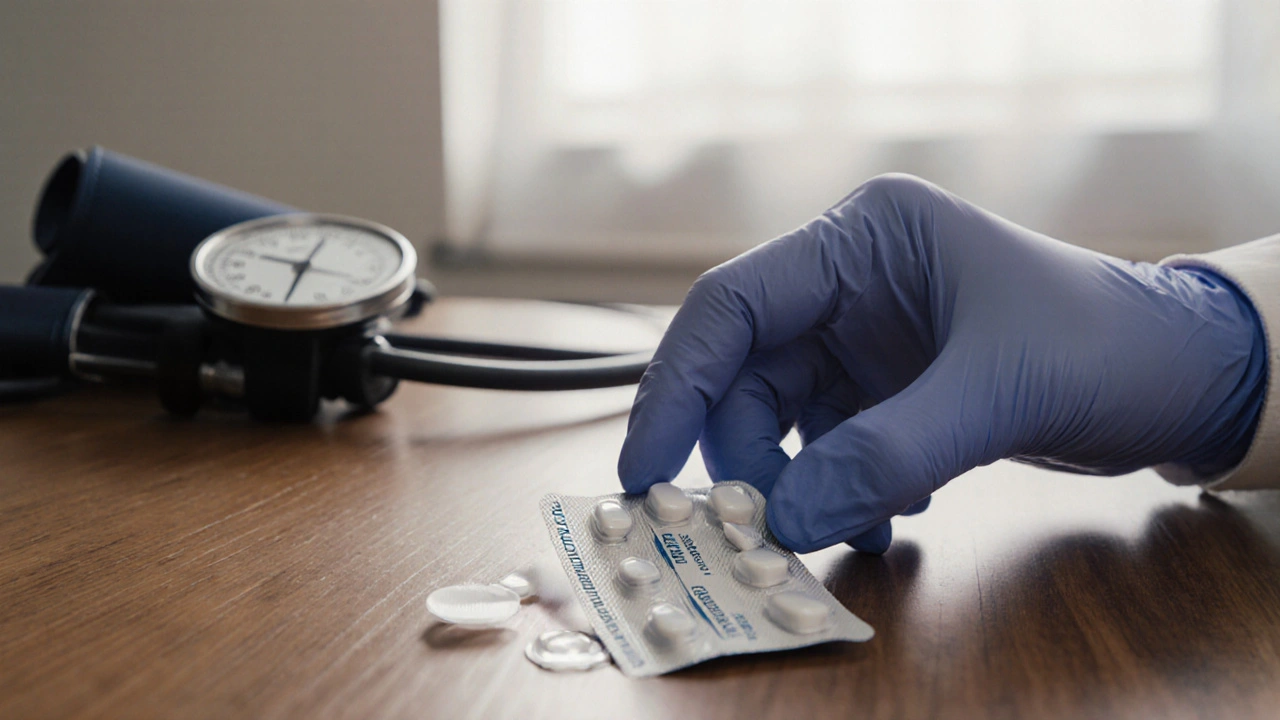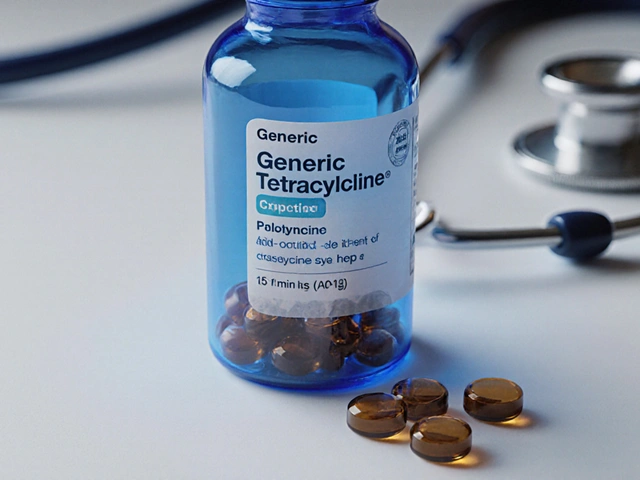Diuretic & Blood Pressure Drug Selector
Use this interactive tool to compare key characteristics of various diuretics and blood pressure medications. Select your top priorities to get personalized recommendations.
| Drug | Mechanism | Dosage | Half-Life | Efficacy (mmHg) | Side Effects | UK Cost (£/month) |
|---|
Recommended Option:
Select your priorities to see personalized recommendations.
When your doctor prescribes a pill to lower blood pressure, you often hear the name Hydrochlorothiazide (Hydrocl). It’s a thiazide diuretic that has been a cornerstone of hypertension therapy for decades. Yet dozens of other drugs can do the same job, some with fewer side‑effects, longer action, or different cost profiles. This guide walks you through the most common alternatives, side‑by‑side, so you can see which one fits your health goals, lifestyle, and budget.
Key Takeaways
- Hydrochlorothiazide works well for mild‑to‑moderate hypertension but may cause low potassium and higher blood‑sugar spikes.
- Chlorthalidone offers a longer half‑life and stronger sodium loss, making it a better choice for resistant hypertension.
- Indapamide combines a thiazide base with a vasodilating effect, reducing the risk of metabolic disturbances.
- Loop diuretics like Furosemide are reserved for fluid overload but can be used when thiazides fail.
- Potassium‑sparing options (Spironolactone) or renin‑angiotensin blockers (Lisinopril, Losartan) are useful when thiazides cause electrolyte imbalance.
How to Compare Diuretics and Blood‑Pressure Drugs
Before you jump into the table, keep these criteria in mind. They reflect what patients and clinicians actually weigh during a prescription decision:
- Mechanism of action - how the drug lowers blood pressure.
- Typical dose range - everyday amounts you’ll likely take.
- Half‑life - how long the drug stays active, influencing dosing frequency.
- Blood‑pressure reduction efficacy - average systolic drop seen in clinical trials.
- Side‑effect profile - especially electrolyte changes, glucose impact, and gout risk.
- Cost in the UK - NHS list price or average pharmacy charge.
Use the checklist below to rank what matters most to you. If you’re prone to low potassium, a potassium‑sparing option may outrank raw efficacy. If you need a once‑daily pill, a longer half‑life wins.
Side‑by‑Side Comparison Table
| Drug | Mechanism | Typical Dose | Half‑Life | Systolic ↓ (mmHg) | Key Side‑Effects | UK Cost (per month) |
|---|---|---|---|---|---|---|
| Hydrochlorothiazide | Inhibits Na⁺/Cl⁻ reabsorption in distal tubule | 12.5‑50mg daily | 6‑15h | ≈8‑12 | Hypokalemia, hyperuricemia, ↑ glucose | £2‑£5 |
| Chlorthalidone | Thiazide‑like, longer distal tubule action | 12.5‑25mg daily | 40‑60h | ≈10‑14 | More profound hypokalemia, edema | £3‑£7 |
| Indapamide | Thiazide‑like + direct vasodilation | 1.5‑2.5mg daily | 14‑18h | ≈9‑13 | Less metabolic impact, rare headache | £4‑£8 |
| Metolazone | Thiazide‑type; works even in low GFR | 2.5‑10mg daily | 8‑15h | ≈7‑11 | Strong potassium loss, photosensitivity | £5‑£10 |
| Furosemide | Inhibits Na⁺/K⁺/Cl⁻ in thick ascending limb (loop) | 20‑80mg daily | 2‑3h | ≈12‑16 | Ototoxicity, dehydration, hypokalemia | £2‑£6 |
| Spironolactone | Aldosterone antagonist (potassium‑sparing) | 25‑100mg daily | 24‑36h | ≈6‑9 | Hyperkalemia, gynecomastia | £1‑£4 |
| Lisinopril | ACE inhibitor - blocks angiotensin‑II formation | 5‑40mg daily | 12‑24h | ≈10‑15 | Cough, angioedema, ↑ potassium | £2‑£6 |
| Losartan | Angiotensin‑II receptor blocker (ARB) | 25‑100mg daily | 6‑9h (active metabolite 13‑15h) | ≈9‑14 | Less cough, possible dizziness | £3‑£8 |
Deep Dive into Each Alternative
Hydrochlorothiazide remains the go‑to thiazide because it’s cheap and widely available. It works by preventing sodium reabsorption in the distal convoluted tubule, which pulls water out of the bloodstream and lowers volume‑related pressure. Most trials show an 8‑12mmHg drop in systolic pressure after a few weeks of therapy. The downsides are well‑known: potassium loss, higher uric acid (risk of gout), and a modest increase in fasting glucose.
Chlorthalidone is often called the “stronger cousin” of Hydrocl. Its half‑life stretches beyond two days, meaning a smoother blood‑pressure curve and once‑daily dosing. Studies in resistant hypertension show it can shave an extra 2‑4mmHg compared with Hydrocl. The price gap is minimal, but the risk of electrolyte shifts is higher, so regular labs are a must.
Indapamide blends thiazide physics with direct vasodilation. In the ADVANCE trial, indapamide reduced cardiovascular events without the sharp rise in glucose seen with Hydrocl. Its low dose (1.5mg) makes side‑effects rare, though some patients report mild headaches.
Metolazone shines when kidney function drops below 30mL/min, where many thiazides lose potency. It still works through distal tubule inhibition, but the molecule is more lipophilic, allowing it to act even in low‑flow states. The trade‑off is a stronger potassium drain and occasional photosensitivity rash.
Furosemide belongs to the loop diuretic family. It’s the most powerful diuretic, capable of dropping systolic pressure by 12‑16mmHg quickly. Because it acts upstream in the nephron, it’s useful when fluid overload (e.g., heart failure) is present. However, its short half‑life demands twice‑daily dosing and it can lead to dehydration and ototoxicity if misused.
Spironolactone blocks aldosterone, preserving potassium while still promoting sodium loss. It’s especially effective in resistant hypertension and primary aldosteronism. Side‑effects include breast tenderness in men (gynecomastia) and a modest rise in potassium that can be problematic if combined with other potassium‑sparing drugs.
Lisinopril, an ACE inhibitor, reduces blood pressure by preventing the conversion of angiotensin‑I to angiotensin‑II. It offers a larger systolic drop (10‑15mmHg) and cardiovascular protection beyond pure blood‑pressure control. The hallmark cough (up to 10% of patients) can force a switch to an ARB.
Losartan works downstream by blocking the angiotensin‑II receptor. It provides similar pressure reduction without the dry cough, making it a common fallback for ACE‑inhibitor intolerants. Its active metabolite extends the effect, allowing once‑daily dosing for most patients.

Choosing the Right Drug for Your Situation
Think of the decision as a match‑making process. Below is a quick guide:
- First‑line, budget‑focused: Hydrochlorothiazide - cheap, effective for most.
- Resistant hypertension or need for stronger effect: Chlorthalidone or Indapamide.
- Low kidney function (eGFR <30): Metolazone or a low‑dose loop diuretic.
- Concern about potassium loss: Switch to Spironolactone or add a potassium‑sparing agent.
- History of gout or high uric acid: Avoid Hydrocl and consider Indapamide.
- Unwanted dry cough from ACE inhibitors: Move to Losartan.
- Need rapid diuresis (e.g., acute fluid overload): Furosemide.
Always pair the drug choice with lifestyle tweaks - low‑salt diet, regular exercise, and weight management amplify the medication’s effect.
Frequently Asked Questions
Can I switch from Hydrochlorothiazide to Chlorthalidone without a washout period?
Yes. Both are thiazide‑type diuretics, so doctors usually transition directly, adjusting the dose based on blood‑pressure response and electrolyte monitoring.
Why does Hydrochlorothiazide raise blood‑sugar levels?
The drug can cause mild insulin resistance and loss of potassium, which together impair glucose uptake. Patients with pre‑diabetes should have fasting glucose checked after starting therapy.
Is Indapamide safe for people with asthma?
Indapamide does not affect bronchial tone, so it’s generally safe for asthmatics. However, any diuretic can cause electrolyte shifts that might trigger muscle cramps, so monitoring is advised.
What monitoring is required when taking Spironolactone?
Check serum potassium and creatinine after 1-2 weeks, then every 3‑6 months. Watch for signs of hyperkalemia such as muscle weakness or abnormal heart rhythm.
Can I take a thiazide and an ACE inhibitor together?
Combining them is common and often more effective, but it increases the risk of low potassium and kidney function changes. Regular blood tests are essential.
Next Steps
If you’ve identified a potential alternative, bring the comparison table to your next GP appointment. Ask for baseline labs (electrolytes, kidney function, fasting glucose) and discuss any existing conditions that could tilt the balance - for example, gout, asthma, or a history of ACE‑inhibitor cough. Adjustments usually happen over a few weeks, so keep a simple log of blood‑pressure readings and any side‑effects you notice.
Remember, medication choice is a partnership. The right drug plus a healthy lifestyle can keep your numbers in range and your quality of life high.








Ashley Stauber October 10, 2025
Most people think hydrochlorothiazide is the default, but it’s far from the only viable option.
Amy Elder October 11, 2025
True, it works for many but there’s room to explore better fits.
Erin Devlin October 12, 2025
Choosing a diuretic is a balance between efficacy and side‑effects.
Will Esguerra October 13, 2025
One must scrutinize the pharmacokinetic profile of each agent with a rigor befitting a peer‑reviewed treatise, lest the clinician succumb to the myopic allure of tradition. The half‑life disparity between hydrochlorothiazide and chlorthalidone alone warrants a reassessment of prescribing habits.
Allison Marruffo October 14, 2025
Your summary captures the essential trade‑offs; for patients prone to hyperuricemia, opting for indapamide can mitigate gout risk while preserving blood‑pressure control.
Ian Frith October 15, 2025
Chlorthalidone’s longer half‑life translates into steadier sodium loss, making it a solid option for resistant hypertension. Its modest price increase is outweighed by the extra systolic reduction you often see in real‑world practice. Just keep an eye on potassium levels, as the deeper diuretic effect can be a double‑edged sword.
Beauty & Nail Care dublin2 October 16, 2025
I’m tellin ya, the pharmaco‑world is a maze 🌪️ and everyone swears by “the good old Hydro‑cl” but hidden gems like indapamide are whispering sweet relief 🚀. Don’t let the marketing hype blind ya!
Oliver Harvey October 17, 2025
Oh, because everyone loves an 80‑hour half‑life, right? :) It’s not like we need to worry about electrolyte swings or anything.
Ben Poulson October 18, 2025
Indeed, a comprehensive appraisal of each agent’s mechanism, dosage flexibility, and socioeconomic impact is indispensable for rational hypertension management.
Raghav Narayan October 18, 2025
When selecting a diuretic, the clinician must first delineate the patient’s renal function, as glomerular filtration rate dictates the efficacy of thiazide‑type agents.
In individuals with an eGFR above 30 mL/min, hydrochlorothiazide remains a cost‑effective first‑line choice.
However, for those whose eGFR hovers near the lower threshold, chlorthalidone’s longer half‑life and sustained sodium excretion often translate into superior blood‑pressure control.
Metolazone should be reserved for the subset with chronic kidney disease where conventional thiazides lose potency.
Loop diuretics such as furosemide are indispensable when volume overload coexists with hypertension, yet their propensity for rapid electrolyte shifts mandates close monitoring.
Potassium‑sparing agents, notably spironolactone, provide a valuable adjunct in resistant hypertension, but the risk of hyperkalemia must be balanced against the benefit.
ACE inhibitors like lisinopril not only lower systolic pressure but also confer renal protection, a dual advantage absent in pure diuretics.
Conversely, the characteristic cough associated with ACE inhibitors often redirects therapy toward angiotensin‑II receptor blockers such as losartan, which maintain efficacy without the respiratory side‑effect.
Indapamide’s combined thiazide and vasodilatory actions render it attractive for patients who experience metabolic disturbances on conventional thiazides.
Cost considerations, while seemingly trivial, can influence adherence; the £2‑£5 monthly price of hydrochlorothiazide compares favorably with the £5‑£10 range of newer agents.
Nevertheless, a marginal increase in expense may be justified if it reduces the need for additional antihypertensive classes.
Patient preference for dosing frequency should not be overlooked, as once‑daily regimens improve compliance more than twice‑daily schedules.
When evaluating side‑effect profiles, clinicians should weigh the risk of hypokalemia against the potential for hyperuricemia and glucose elevation.
Lifestyle factors, including dietary sodium intake and alcohol consumption, can modulate the pharmacodynamics of any diuretic.
Ultimately, the decision rests on a shared decision‑making process that integrates clinical evidence with individual patient values.
By systematically applying these principles, practitioners can tailor therapy to achieve optimal blood‑pressure reduction while minimizing adverse outcomes.
Kelvin Murigi October 19, 2025
If you want a drug that punches hypertension without pulling your potassium into a free‑fall, spironolactone is the artillery you need.
ahmad matt October 20, 2025
Choosing hydrocl is a lazy move that shows you didn’t read the guidelines
kristine ayroso October 21, 2025
I think its crutial to consuder the patien's lifestyle when pickin a med
Ben Small October 22, 2025
Stay motivated and keep tracking your BP.
Dylan Hilton October 23, 2025
Great discussion, everyone! Remember to review the latest NICE guidelines for the most up‑to‑date recommendations.